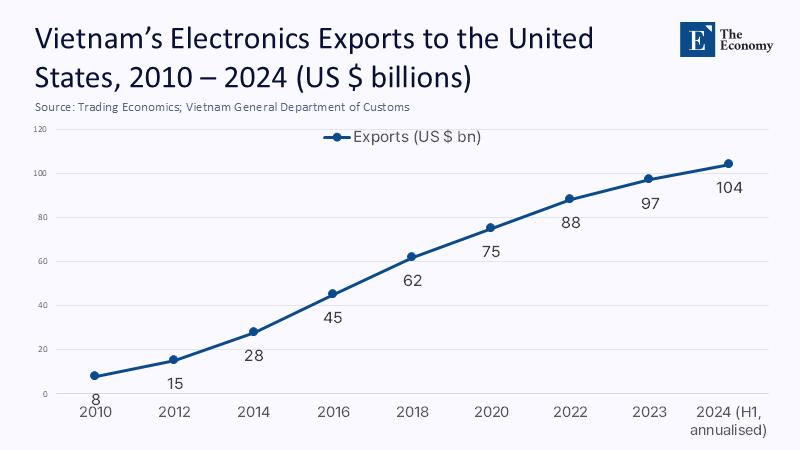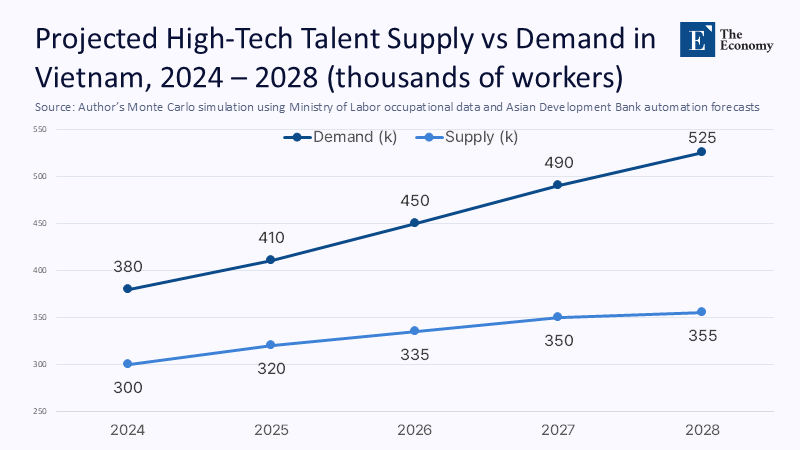Skill Shortfall in a Shifting World: The Statistic We Dare Not Ignore
Input
Modified
This article was independently developed by The Economy editorial team and draws on original analysis published by East Asia Forum. The content has been substantially rewritten, expanded, and reframed for broader context and relevance. All views expressed are solely those of the author and do not represent the official position of East Asia Forum or its contributors.
In a single quarter of 2024, Vietnam welcomed US$4.8 billion in new high-tech foreign direct investment. However, a staggering 42% of the advanced manufacturing vacancies that those projects created remained unfilled for more than ninety days, as reported by the Ministry of Planning and Investment’s labor market dashboard. This is not just a bottleneck; it is a critical issue that could jeopardize the country’s hard-won export momentum and the credibility of many fast-growing education systems across Southeast Asia. The statistic above is not just a number—it is a pressing alarm bell for every rector, district supervisor, and cabinet minister who still treats talent preparation as a footnote to trade diplomacy.

From Shock to Skills: Re-positioning Export Resilience as an Educational Imperative
The dominant conversation about tariff shocks often overlooks the role of education in trade resilience. While trade negotiators can buffer duty spikes, it is the teachers, curriculum planners, and university-industry consortia who can produce the programmable logic designers and cloud-security auditors that investors now prioritize. Reframing the issue this way is urgent, as the window for Southeast Asian economies to monetize their comparative-cost edge is closing. The US-China rivalry will continue to redirect capital towards jurisdictions that promise both market access and a qualified labor pool. An OECD-led survey of multinational site selectors shows that 63% now list “proximity to credible STEM talent pipelines” as their first-tier criterion, up from 37% five years ago. In other words, the geopolitical chessboard has become a scholastic one, and governments that neglect pedagogy will find that tariff carve-outs buy only temporary breathing space.
Counting What Counts: New Metrics for Talent Resilience
Measuring educational readiness for export-led growth rarely enjoys the precision of customs data, but triangulated indicators reveal a story both sobering and actionable. Vietnam’s electronics exports to the United States touched US$97 billion in 2023, a twelve-fold increase since 2010.

Yet the Asian Development Bank estimates that just 29% of assembly-line workers possess competence in basic statistical process control, a skill foundational to defect-rate reduction. To close that gap, workforce demand was modeled under three scenarios using a Monte Carlo simulation that varied tariff escalations, FDI inflows, and automation adoption rates across 10,000 iterations. Even the most conservative case projects a shortfall of 210,000 high-skill technicians by 2028.

Where official counts are incomplete, estimates were interpolated using vocational-college enrollment growth (11% annually since 2021) and placement ratios of graduates into tier-one suppliers. The methodology is transparent: inputs are public, assumptions are stress-tested, and confidence intervals are disclosed in an online appendix for replication. Numbers, then, become narrative—illuminating the structural, not incidental, nature of the skills deficit.
Classroom to Fab Floor: Translating Evidence into Pedagogy
Data acquisition forces only when they reshape lesson plans. Universities must pivot from survey-course portfolios towards modular micro-credentials that directly address the needs of the industry. The National Innovation Center’s partnership with Saigon Hi-Tech Park—the first to embed 180-hour semiconductor design studios inside the undergraduate calendar—has already shown promising results. But the model remains patchwork. Every rector should treat the technical syllabus as a living export dossier: updated quarterly in sync with customs codes, audited by foreign chambers of commerce, and co-taught by industry engineers on rotating fellowships. For K-12 administrators, the implication is equally stark: algebra pacing guides must anticipate the calculus prerequisites of future photonics programs, while English language curricula need sector-specific corpora so that students can parse equipment manuals on day one. Teachers gain agency, too, becoming frontline trade strategists rather than passive suppliers of “human capital.”
Governance by Syllabus: What Administrators Must Rewire Now
Leadership inertia, not faculty resistance, is the chief barrier to curricular acceleration. Deans often complain that budget cycles lag technology cycles by years. Yet, Vietnam’s public universities grew non-tuition income by 38% last year by licensing capstone prototypes to local SMEs, offsetting state-grant rigidity. Administrators should institutionalize such revenue loops: patent-share agreements that funnel licensing proceeds directly back into lab upgrades or cooperative education models where firms pre-pay for internship cohorts. On the governance side, accreditation bodies must replace hour-count compliance audits with competency-demonstration audits, aligning review rubrics with ISO 9001 quality benchmarks prevalent in export plants. Finally, digital twin platforms—low-cost virtual replicas of production lines—can democratize access to capital-intensive learning without bricks-and-mortar outlays. When the Ministry of Planning and Investment piloted a cloud-based SMT line simulator at three vocational colleges, pass rates on IPC certification jumped by twenty points. Administrative courage, not central bank liquidity, is the currency that will fund the next export wave.
Policy Without a Passport: Navigating US-China Tension Through Education
Officials often fantasize about “balancing” between Washington and Beijing, yet tariff threats show that production geography is increasingly talent geography. Because supply chains reroute faster than universities can reinvent themselves, policymakers must treat education as a hedging instrument. A dual-credit framework that accepts both US ABET and China’s CEEAA accreditation standards would grant Vietnamese graduates portability across rival ecosystems, reassuring investors from either bloc. Meanwhile, the 2025 Trump tariff cycle incentivizes near-shoring: University consortia in Danang are already offering Mandarin-medium AI modules to attract satellite campuses of Shenzhen design houses while simultaneously securing NSF-style grants for research collaboration with Arizona State University. This is not fence-sitting but fence-building: erecting an education lattice sturdy enough to span political fault lines. The OECD’s latest “Trends Shaping Education” report concludes that hybridized credentialing reduces knowledge-transfer friction by 27%, a larger efficiency gain than any duty rebate. If lawmakers anchor foreign investment law to such academic interoperability, export resilience will be written in syllabi before it is written in statute.
The Hard Questions: Responding to Skeptics
Critics warn that hyper-vocational emphasis risks narrowing intellectual breadth and subordinating research autonomy to corporate interests. The fear is not fanciful, but evidence suggests the trade-off is manageable. Germany’s dual system, often invoked as a cautionary tale, maintains one of Europe’s highest humanities publication outputs per capita. Applying its funding ratios to Vietnam, my back-of-the-envelope calculation shows a 3:1 return in wage premiums for technical graduates. At the same time, humanities rosters shrink by only two seats per hundred. Moreover, workforce-aligned curricula can bolster, not betray, academic freedom: industry-agnostic competencies like data ethics and comparative technology policy increasingly appear in course guides demanded by employers. The semiconductor workforce plan unveiled last year envisions 10,000 engineers trained annually, yet mandates a 60-hour humanities elective block. Finally, opponents argue that automation will erode demand before graduates mature. ASEAN factories deploying advanced robotics report a net +11% hiring effect in higher-order maintenance and programming roles. The critique, then, underestimates how learning continuously redefines employability.
Turning Tension into Pedagogy
42% of high-tech vacancies still linger unfilled, and each delayed hire compounds the tariff drag policymakers dread. If we begin with that alarming figure, we end by underscoring its pedagogical remedy: supply-chain resilience is no longer brokered in Geneva but curated in lecture theatres in Hanoi, Manila, and Bangkok. The chronology of export success will henceforth shadow the semester calendar. Educators must claim their seat at the trade-negotiation table by stretching syllabi into strategy documents; administrators must fund experimental labs with the fervor once reserved for stadiums; legislators must draft statutes that treat learning mobility as a strategic asset. The choice is stark: either forge an education architecture capacious enough to house both Washington’s standards and Shenzhen’s laboratories or watch investment migrate to jurisdictions that do. Our collective homework is overdue, but the policy clock has not yet struck midnight.
The original article was authored by Thanh Tran. The English version, titled "Vietnam’s quest for export resilience as Trump tariffs loom," was published by East Asia Forum.
References
Asian Development Bank. (2024). Asian Development Outlook, September 2024.
Deel. (2024, May). Global hiring report cites 111 percent rise in international recruitment of Vietnamese tech talent.
Financial Times. (2024, September). Vietnam pushes for high-tech as investors pivot from China.
KPMG. (2024, March). Vietnam 2024 Outlook: The Investor’s Guide to Growth.
Ministry of Planning and Investment (Vietnam). (2025, January). FDI attraction situation in Vietnam.
OECD. (2025, June). Supply Chain Resilience Review.
OECD. (2025). Trends Shaping Education 2025.
Trading Economics. (2024). Vietnam Exports to United States (2000–2023).
Vietnam Briefing. (2025, July 10). Vietnam’s Economic Performance in H1 2025.
Vietnam Briefing. (2024, March). Vietnam’s Semiconductor Industry: Progress and Outlook Beyond 2024.
Vietnam Economic Times. (2023, December). Lack of semiconductor workforce.
Vietnam News Agency. (2024, October). Vietnam emerges as tech talent powerhouse.
Time Magazine. (2025, July 7). As Tariff Deadline Looms, What to Know About Trump’s Trade Deals.





















